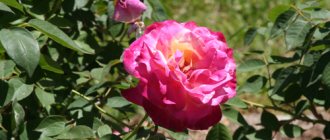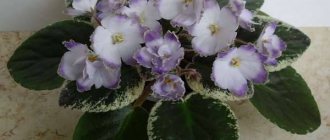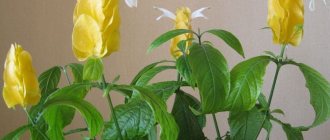What it is?
Brief biological description
According to its description and characteristics, azalea is classified as an evergreen shrub, the height of which varies from 50 to 150 cm. Its scientific name is Azalea. The flowering period depends on the plant variety. It is abundant and the flowers are large. They have different colors.
What does a houseplant look like?
The elliptical leaves of the plant are small in size.
They are dark green in color, slightly shiny on top and very soft to the touch. Most often omitted. The flowers have a tubular funnel-shaped or flat shape. They form on the tops of last year's shoots. Flowers can be either single or bicolor. The color can be very different. Flowers are:
- Simple - have about 5-6 petals and 5 stamens.
- Terry - they have a different number of petals, which can grow directly from the stamens.
- A flower within a flower has 112 petals, as well as a cup that forms the petals.
Certain plant varieties have a pleasant aroma.
Passport
Azalea belongs to the genus Rhododendron and the Heather family . There are about 1000 species of this plant. Azalea is a small shrub that blooms in indoor conditions in the winter.
Country of origin
Its homeland is Japan and China. In the natural environment it is also found in North America, as well as in the southern part of Europe.
Description of the flower
The bush is medium-sized, climbing, its leaves are pinkish in color, which is why it was called “pink tree.” Azalea leaves come in a huge variety of different colors, ranging from all colors of pink to white leaves. Such a plant can be late flowering or early flowering.
Azaleas habitat:
- Asia;
- China;
- Japan;
- Eastern countries.
Growing without human intervention in the northern United States. In the Far East, this flower is a symbol of prosperity and tranquility.
This is a special plant because its designation affects only one subgenus, the Rhododendron genus. But gardeners use two names.
The deciduous species are azaleas and the green species are rhododendrons.
Confusion may occur in different countries and regions, as the same plants are sold only under a different name, this is due to the popularity of the species.
Azalea can serve as a gift, since this flower at the very peak of flowering looks incredibly beautiful and pleases the eye, but its disadvantage is that it quickly withers and you have to throw it away.
Azalea is an autumn plant, it grows in November and loves the cold, its favorite temperature is ten degrees, which is why it will not get along in an apartment, it constantly needs humidity and coolness.
If it is grown in a greenhouse or garden, then the necessary conditions for the flower are created, but in a room on the windowsill it will quickly die.
Ardent flower fans know how to create the necessary living conditions for a flower. You can keep it in your room, the main thing is to study this flower in more detail and give it the environment it needs.
Plant species
The variety is usually grown indoors or in the garden based on two popular ones:
- Azalea Simsa
- Japanese azalea, in the photo of the azalea you can see their beauty; although they are from the same species, they are very different and dissimilar.
Such bushes are considered dwarf and do not reach a height of more than fifty centimeters. Based on some varieties, many hybrids were created. They are not similar in size, structure and flowers.
Where did the name come from and what does it mean?
Azalea
Azaleas are certain types of Rhododendrons that are adapted for growing at home. The name of the flower translates as “dry”. It is related to the appearance of the plant, as it is a dry shrub.
Rhododendron
It was customary to include all evergreen species of this plant that grew outdoors as Rhododendrons. Only deciduous indoor species were called azaleas. The name is translated from Greek as “rose tree”.
Azalea and rhododendron - is there a difference?
From a biological point of view, plants have a lot in common.
- Both members of the family form shrubs covered with shiny, succulent foliage.
- During the flowering period, huge inflorescences consisting of many bright buds open on the branches of azalea and rhododendron. The flowers often emit a strong honey aroma.
- The color of the petals is varied: white, yellow, purple, crimson, pink.
- Plants are equally demanding of air humidity and love loose soil with high acidity. Their shallow root system does not allow for deep loosening of the soil, so the ground under the bushes is mulched.
Blooming rhododendron is beautiful and bright
Such a number of common characteristics leads many gardeners to believe that it is not so important whether to plant an azalea or rhododendron in the garden. This is a misconception that can have a detrimental effect on the growth of the seedling.
All representatives of the azalea genus do not tolerate low temperatures (they die at +4 degrees), and are able to grow in open ground only in the southern regions of Russia (Crimea, Stavropol region). In the rest of the territory, these plants are grown as house or greenhouse flowers.
Historical confusion
The first mention of the beautiful flowering shrub "azalea" dates back to the 5th century BC. Even then, the wonderful flowering delighted the ancient Greeks. Later, plants with a similar trunk and flower structure began to be found in the foothills of the Himalayas, the Caucasus, Southeast Asia and North America.
On a note! The name "azalea" translated from Greek means "dry". Given to the plant because during the dormant period it is completely free of foliage and looks lifeless. The name "rhododendron" means "rose bush (tree)", and indicates the splendor and brightness of flowering.
Botanists have long believed that azalea and rhododendron are two genera belonging to the same family, differing in size and resistance to cold. Azalea forms a compact bush, no more than half a meter high and does not tolerate frost. Rhododendrons can grow up to 3 m in height, and are not so demanding on weather conditions (withstand frosts down to -20 degrees). Currently, a different classification has been adopted in botanical circles.
Modern classification
Today, scientists, after conducting a series of genetic tests, have included all varieties of azalea in the genus Rhododendron. In other words, it is correct to consider an azalea a rhododendron, but not vice versa.
In the garden classification, azaleas continue to be classified as a separate group, pointing out the difference in the structure of the flower. There are 5 stamens in its bud, while rhododendron has 10 or more. In addition, Russian gardeners clearly know that miniature bushes can only be grown at home.
What is the lifespan and can it be extended?
The flower can grow for 5-6 years. In order to extend the flowering period of a plant, the gardener must comply with conditions that rely on natural adaptations.
The lifespan depends on how the azalea goes through the seasons. She needs a period of rest and should sometimes be taken out into the cold. Azalea loves bright light, but does not tolerate sun very well. It should be kept in a bright, cool room. This could be a winter garden, a frost-free balcony or a greenhouse. If you follow these recommendations, you can extend its flowering period.
How it is used in landscape design
Low varieties of Azaleas can be planted in groups or along paths and paths . They will look beautiful if combined with low conifers such as juniper.
Azalea will be a good decoration for any garden
Tall ones are planted in the background of landscape designs or as tapeworms in the center of a flower bed. Using tall varieties, if winters permit, you can make living, beautifully flowering fences.
Benefits and harms
- First of all, her appearance alone can lift a person’s mood. In addition, it is believed that people who grow azaleas rarely experience depression.
- The plant purifies the air and brings pleasant floral freshness to the room.
- The flower also has medicinal properties. If a person has barley, then you need to apply a plant petal to it, after which it will soon go away.
The harm of azalea lies in the fact that its leaves cannot be eaten. If a person does eat the leaf, his heart rhythm will be disturbed, and intestinal colic will begin. Therefore, you need to ensure that children and pets do not eat its leaves.
It also tends to saturate the air with a strong and persistent aroma during flowering, which can cause headaches and allergies in the form of spots on the skin.
In addition, rhododendron can be used to make an invigorating and healing tea. Read about how to do this correctly, as well as the benefits and harms of the drink here.
Forcing a houseplant azalea
In order for the Indian azalea to bloom in winter, it needs to create certain conditions in the fall. Many varieties sold as winter bloomers are well adapted to forcing to produce blooms during certain months. Varieties and hybrids that are supposed to bloom later may respond to forcing by the appearance of a large number of unopened, dried out and ugly buds.
In November or the first half of December, azaleas are temporarily moved from a cool room to a warm room in a bright, sunny place. Recently transplanted plants are not suitable for forcing; they may lose all their foliage. Water azaleas regularly only with warm water. The earthen clod must not be allowed to dry out.
In clear weather, plants are sprayed with a fine spray, thoroughly moistening the lower surface of the leaves. This procedure is very important, since in dry air conditions thrips and spider mites harm azaleas, which often leads to the death of the plant.
Soon, at the ends of all strong branches, thick and dense flower buds that were laid earlier will begin to swell. After two to three weeks, the integumentary scales surrounding the buds will begin to move apart, and a bud will appear from their middle. Those covering scales that do not fall off on their own are carefully removed. All light green shoots that appear next to the buds and flowers are pinched. When the buds begin to bloom, the blooming azalea is transferred to a cool place.
Types and photos
It is customary to distinguish 2 main types of plants, from which subspecies originate:
- Indian azalea - it has luxurious funnel-shaped flowers, the size of which is 3.5 cm. The shoots are covered with bristles.
- Japanese - it is characterized by glossy leaves. The diameter of the flowers is 3 cm. It is a recognized national plant in Japan.
Next in the photo you can see what a rhododendron looks like in a pot in an apartment, what color it comes in, and there is also a full-length photo of the plant at home.
Azalea in signs, dreams and folk traditions
This beautifully flowering plant is credited with supernatural powers. So finding this flower in a living room and even in a garden helps its owner find happiness, gain patience and self-confidence. If a flowerpot with an azalea is placed in the workplace of a person of creative professions, he will not only be inspired to create another masterpiece, but will also complete the work he has started.
If you see a blooming azalea in a dream, then it is interpreted as an improvement in well-being in the near future, but a faded shrub has the opposite meaning. In general, such an evergreen plant in a dream is regarded as the onset of long-awaited changes in life for the better.
Such famous poets as N. Gumilev, A. Kuprin, A. Fet, D. Mamin-Sibiryak, K. Paustovsky wrote about the original forms of azalea flowers, its shoots and leaves.
This graceful plant can be seen at many art exhibitions. Basho sang his praises, admiring the beauty of the flowers and comparing them to a rainbow. For the Japanese, the azalea is as important as their national symbol, the sakura.
Growing at home
Let's look at 3 common methods of planting azaleas, which have significant differences among themselves.
Seedlings
Best suited for a plant that was purchased recently. Planting is carried out in the spring after the flowering period ends. To do this you need:
- Place the pot of azaleas in water to moisten the soil and root system. 20 minutes will be enough.
- After this, you need to remove the flower from the pot and use a knife to cut it into 2-3 parts. This must be done carefully so that the root system is not damaged. If possible, it is best to untangle the tangled roots by hand.
- Without shaking the soil from the roots, the plant should be immediately planted in a pre-prepared pot that contains a drainage layer.
Seeds
Not the easiest way, but also popular:
- It is also held in the spring . The seeds of the plant need to be mixed with sand, after which they are ready for sowing on the surface of the soil.
- Crops need to be covered with film . There should be high humidity inside and a temperature between 23 and 25 degrees Celsius.
- After 3-4 weeks the first shoots will be noticeable . After leaves appear on them, they need to be picked. If the seedlings are 12 cm high, they should be planted in separate pots.
Cuttings
Thanks to this planting method, after 2 years the gardener will be able to enjoy mature plants. The landing principle is as follows:
- It is necessary to cut cuttings from the tops of last year's shoots.
- Rooting is carried out in greenhouse conditions. To do this, you need to deepen the cuttings 2 cm into a light, loose substrate. Then they need to be watered moderately and also sprayed with water. The greenhouse should be ventilated regularly. Temperature: 25 degrees Celsius.
- When the cuttings have their own shoots, they can be taken from the greenhouse. Then plant the plants in pots.
Read more about the azalea root system and how to root the plant here.
When planting azaleas, it is very important to choose the right soil so that the rather finicky flower to care for will feel great both during normal propagation and when grown in a trunk.
2.Planting and care in open ground
The main difficulty when growing in open ground is maintaining the correct acidic pH of the soil and good preparation for wintering.
Planting in open ground is carried out in the warm season - from spring to mid-autumn, when there are no prolonged frosts.
For the azalea, prepare a location that will be protected from the too hot rays of the sun at noon; you can plant the flower under the canopy of trees. Also, such a place should be protected from strong gusts of wind.
↑ Up,
↑ Up,
For planting, holes with a depth of 40 to 50 cm; a good layer of drainage in the form of broken clay pots, expanded clay and coarse river sand is placed on the bottom.
To fill the holes , make up soil with a sufficient amount of acidic peat of fallen pine needles and tree bark.
The flower is removed from the transport container and transferred to the hole, preserving the earthen lump if possible. Since azalea grows in symbiosis with special fungi - mycorrhiza, the presence of old soil is necessary.
The bushes are sprinkled along the perimeter with a fresh peat-based mixture and the substrate is compacted around the base of the plant to remove air pockets.
↑ Up,
The planting pattern will depend on the final size of the plants - between bushes of large varieties it is necessary to maintain a distance of about 1 - 1.5 m , while smaller varieties can be planted at a distance of 50 - 70 cm .
to cover the bases of flowers based on pine bark - it will prevent the appearance of weeds and will prevent the rapid evaporation of moisture from the surface of the soil.
After planting, the bushes are watered abundantly , adding dry mycorrhiza powder, which can be purchased at a flower shop, to the watering water. Only planted plants will need regular and abundant watering.
↑ Up,
Further care of the planted plants will consist of timely watering and fertilizing, as well as loosening the soil.
Since the root system of rhododendron is located superficially, loosening should be carried out with caution , and the soil should not be allowed to dry out.
For fertilizing, use only fertilizers specifically designed for azaleas and rhododendrons - they will help maintain the required low soil pH level. From time to time, you can use foliar fertilizing with iron chelate, applying it to the leaf blades using a sprayer.
↑ Up,
2.1.Preparing for wintering
Before the onset of frost, approximately in mid-autumn, the bushes are shed very generously with water and a thick layer of mulch .
In the middle zone, for growing in open ground, you should use only deciduous plants that tolerate frost better.
To insulate plants, spruce branches, fallen leaves or non-woven material are used, and such shelters are sprinkled with snow on top.
To prevent the flower from rotting away, a small slate shelter is also built over it.
As soon as the snow melts in this area, the shelter is immediately removed.
↑ Up,
After warming, the bushes are carefully inspected and frost-damaged, old and diseased branches are removed . Also, when pruning, shoots directed into the bush and thickening the crown are removed.
With the help of timely and competent pruning, you can form an azalea in any geometric shape.
↑ Up,
Features of care
Lighting in an ordinary apartment should be diffused; light partial shade from northern or western window sills is allowed. In order for the plant to grow and develop normally, the room temperature must be maintained at 15-18 degrees Celsius. Azaleas need to be watered very often and abundantly. This must be done every day.
The frequency of watering depends on the level of air humidity. It is recommended to place pieces of ice on the surface of the soil, which will melt and thus saturate the substrate with moisture, as well as refresh the flower on summer days.
Periodically, it is necessary to dissolve a teaspoon of lemon juice in 2 liters of water, and then water the plant with this mixture. With the arrival of autumn, you should water the plant less often. When the flowering period begins again, it should again be frequent and abundant.
Azalea needs high air humidity . The plant should be sprayed. It can also be placed on a tray with wet pebbles.
As for feeding, in summer and spring it is carried out once a week. With the onset of winter cold, the plant needs to be fertilized once a month. As a top dressing, you should use a special mineral complex for Azalea. Any other compositions that are intended for flowering plants and do not contain chlorine are also suitable.
When the active growth of the plant begins, the gardener needs to shorten the shoots that have grown strongly. During the growing season, you need to pinch the tops, so that the azalea will not bush too much, and the flowering will be abundant. Transplantation is carried out only when the plant becomes cramped in the pot.
After flowering, the plant begins a dormant period that lasts 2 months.
We invite you to watch a video about the features of caring for azaleas:
Azalea - queen of the garden
It is impossible not to admire azalea. Its delicate flowers of different beautiful shades (pink, white, peach, bright orange, lavender, red) inspire poets and artists to write poems and paintings. Caring for and growing garden varieties includes following certain rules, which we will talk about now.
- Landing place.
An ideal location may be a part of the garden sheltered from the wind (along the north or east side of the house) that receives indirect sunlight in the afternoon.
Azaleas look most attractive when they are planted as single bushes . Mass plantings look good only in large garden plots. They are placed in the light shade of coniferous trees such as pine trees (since they have acidic soils that are suitable for azaleas).
Gardeners need to remember: direct sunlight, especially in warm southern regions, burns azalea leaves, and strong shade deprives it of oxygen, which causes poor flowering and weak plant growth.
- The soil.
Azaleas have shallow roots, so they need well-drained (loose), acidic soil with a pH of 5.5. For this reason, planting plants along the foundation of a house is not an option, as the soil there tends to be more alkaline. Increase acidity with rotted manure and inorganic substances or leaf soil in combination with ground pine bark.
- Landing rule.
In many garden plots, azaleas do not take root due to clay soil. There are two ways to solve this problem:
- make mounds (beds) 20–30 cm high from equal parts of good garden soil and organic matter (crushed pine bark, peat or compost);
- pour organic matter into the holes when planting plants in the ground. The depth of the holes should be about 50 cm. They are made three times wider than the root ball. Sand or broken brick is poured onto the bottom, covering the drainage with a mixture of garden soil and organic matter (1:1). Then the bush is placed so that 4–5 cm of the root ball is above the surface of the ground. Add organic matter, filling the remaining free space of the hole, and then rake it to the top of the root ball (so that a mound is formed above the soil surface).
After planting, the ground under the bushes is covered with mulch (shredded last year’s leaves, bark or pine needles) at a distance of 5–7 cm from the azalea trunk. Mulch protects plants from weeds even during wintering;
- maintains stability of temperature and humidity in the soil;
- increases its acidity;
- Provides azalea with sufficient nutrients.
Low-growing plants are covered with mulch (and spruce branches) for the wintering period. In tall varieties (young deciduous azaleas), in winter the branches are bent to the ground so that they are covered with snow.
- Feeding.
Once the azalea has been planted, care at the next stage includes watering and infrequent feeding from late spring to early autumn. Fertilizers are applied as needed when soil nutrients become deficient. It manifests itself as stunted plant growth, yellowing or early falling of leaves.
- Watering.
See also: Caring for oxalis at home
The azalea flower prefers moist soil, so it is always watered when there is no natural precipitation (not with hard cold water from a hose, but with warm, settled water or rain). It is important to do this every day during long dry periods (even in autumn) at the same time as spraying non-flowering bushes. After planting, the first watering is done three weeks later.
- Trimming.
The procedure is carried out after flowering, in autumn. Thanks to pruning, in the spring the stems of the bush begin to branch, which makes the plant attractive and able to grow more vigorously, including having more flowers. Cut the stem at an angle of 45°, half a centimeter above the node (where the leaf or shoot is attached to the stem), cover the cut with garden varnish. Tools for work must be clean and sharp. It is recommended to wear gloves, as the branches of the plant are poisonous.
- Reproduction.
At the beginning of autumn, lignified healthy cuttings about 7 cm long with two to three leaves are cut from the bush. Root them in a container with peat and sand, inserting them at an angle of 45°. Water and cover with film or a plastic bottle with the bottom cut off to create greenhouse conditions. After 2–4 months they are transplanted into nutrient soil, and after a year - into the garden.
The long-term method of propagation is by seeds. Depending on the variety, it is possible to grow an adult flowering bush only after several years. The scheme for planting seeds is known to all gardeners: the seeds are sown in nutrient soil, previously spilled with boiled water, covered with glass or film, sprayed and ventilated every day. Shoots dive into individual containers. Transplantation into the garden is also carried out after 12 months.
Gardeners often use alternative propagation methods:
- by dividing the bush (the same as when transplanting Anthurium);
- side shoots, bending them to the ground and covering them with earth.
Flowering and what to do if it doesn’t bloom?
The flowering period varies from 2 to 6 months. Lasts from December to March. It happens even until April. In most cases it blooms very luxuriantly and abundantly. Flowering may not occur for the following reasons:
- The flower is kept in too warm conditions.
- The soil does not receive the necessary nutrition.
- The flower is in the open sun or in a too dark place.
- No pruning or pinching was done.
In this case, it is necessary to determine the reason for the lack of flowering and correct it.
How to Grow Azalea Bonsai
Bonsai is a tree in miniature. It can be formed from either an outdoor Azalea or an indoor one, but there will still be a difference in the height of the bush. But the most beautiful creations are those that nature makes with its own hands. But a person with imagination and taste for shaping a bush can always create a bonsai for himself.
There are different forms of bonsai for Azalea:
- Cascade;
- Spiral;
- Sloping, when the top tilts in opposite directions.
Azalea bonsai
All flower pruning is carried out in the spring, at the time of active growth of the stems and before the onset of summer heat. When trimming a plant, you should be careful about its top , since if you trim it, the side branches will begin to grow much faster. This pruning period occurs after flowering and transplanting the plant into a new container.
Briefly about reproduction
This plant is propagated by stem cuttings. The most optimal time for reproduction is summer .
- Semi-lignified cuttings with buds must be planted in the ground.
- Any flower buds that appear should be removed immediately.
- A few months later, the cuttings are planted in a pot.
We invite you to watch a video about how to propagate azaleas:
Diseases and pests
- If the azalea leaves turn yellow, begin to wither and fall off, this indicates improper watering or exposure to direct sunlight. To solve the problem, you need to follow the watering rules, spray the plant and hide it from the sun.
- If gray rot or rust appears, the temperature in the room should be adjusted, and all damaged leaves of the plant should be removed.
- Excess moisture in the soil leads to late blight, which can cause the plant to die.
Pests that can harm azaleas:
- scale insects;
- strawberry and spider mites.
To solve the problem, you need to use special products that treat the leaves of the plant.
You can read more about pests and diseases of azaleas in a separate article.
3.Azalea propagation
Vegetative propagation of azaleas using stem cuttings , but cuttings rarely guarantee a positive result and rooting takes a long time. It is especially difficult for deciduous rhododendrons to reproduce in this way.
- Semi-ripe cuttings 5-10 cm long with 2-3 internodes are soaked for several hours in a solution of growth hormones.
- First, remove the top layer of bark from the lower end of the cutting to a height of approximately 2 cm.
- When rooting, buds and lower leaves are removed so that the plant does not lose too much moisture.
- The cuttings are planted in a nutritious acidic substrate - for example, in peat mixed with sand to a depth of about 1.5 - 3 cm.
- The soil around the planted cuttings is thoroughly compacted.
- The cuttings are covered on top with a transparent plastic bag , glass or plastic cap to maintain uniform humidity
- Plants are periodically ventilated , gradually increasing the time. The cover is removed only after 3 - 4 months, when there is confidence in successful rooting.
- In the room where rooting takes place, the air temperature should be 24 - 26 ° C. It is advisable to use bottom heating .
- Small bushes should not be exposed to direct sunlight.
- The first pruning is carried out when young plants reach a height of 10 - 12 cm.
too old shoots for cuttings - they will not take root.
↑ Up,
Rhododendrons also reproduce by air layering - for this, long branches located close to the ground are bent, pinned and lightly covered with soil.
After some time, roots appear in the leaf node of such layerings.
The successful completion of the rooting process will be indicated by the new growth that appears within 2 - 3 months .
↑ Up,
The most rarely used propagation method is growing azaleas from seeds . The fact is that plants obtained in this way may not inherit all the varietal attractiveness of their parents, and the first flowering will occur only at the age of 3 - 4 years .
The highest percentage of germination is observed in fresh seeds.
- Sowing is carried out in the spring in a light, well-moistened and nutritious substrate.
- From above, the seeds are only slightly pressed into the ground , without covering them with a layer of soil.
- Instead of watering, moistening is used by spraying with softened water at room temperature.
- The seedlings are covered with a transparent plastic cap on top to maintain a uniformly high level of humidity and placed in a well-lit place without exposure to direct sunlight, at a temperature of about 20°C .
- The first shoots can be seen within 3 - 4 weeks .
- With the appearance of the first shoots, the seedlings are ventilated , gradually increasing the time from several minutes a day.
- Watering is carried out from the bottom - into the drainage holes of the container.
- Young plants will need long daylight hours, so it is advisable to provide them with artificial lighting .
- The sprouts dive into separate cups with the appearance of the first true leaves.
One of the positive aspects of this method of propagation is the production of flowers that are initially adapted to indoor conditions.
If seedlings are grown for open ground, then young bushes are taken outside for the first time at the age of 3 - 4 years, gradually hardening and accustoming them to new conditions.
↑ Up,
What similar plants are there?
- Daurian rhododendron - it has small leaves and branches directed upward. It can be up to 2 m in height. The flowers are funnel-shaped. They are pink-purple in color and very large.
- Canadian rhododendron is a low-growing shrub, the height of which does not exceed 1 m. It has very long leaves - up to 6 m. The flowers are pink-purple in color.
- Jasmine gardenia is a very small bush, the height of which varies from 45 to 50 cm. The leaves are dark green and the flowers are white and double. It has a very pleasant smell.
Inexperienced gardeners may confuse azaleas with other unusual plants. You can read about its similarities and differences and other colors in our material.
This flower can become the main decoration of any home, but to do this you need to know everything about the specifics of growing azaleas at home. Otherwise, you won’t be able to see the beautiful flowering of the plant.
9.Types of azaleas:
9.1.Japanese azalea - Azalea japonica
One of the evergreen subspecies of the plant, the shrubs reach a height of 2 m and bloom in spring. The leaves are oblong-oval, light green, slightly bent along the central vein, the leaf blades are glossy. The flowers are funnel-shaped, with slightly ruffled petals in all shades of pink, lilac, salmon, white or red.
↑ Up,
Japanese azalea "Geisha" - Azalea "Geisha" - relatively low plants ranging from 40 to 60 cm. The leaves are glossy, teardrop-shaped or oblong-oval, young leaves are painted in a lighter shade. The flowers are white, pink, purple, orange, funnel-shaped. There are two-color types.
↑ Up,
Japanese azalea "Maruschka" - Azalea japonica "Maruschka" - is a small evergreen shrub with dark, burgundy oval-shaped leaves, reaching a height of 30 - 60 cm. The flowers are large, pinkish-salmon, bloom in May.
↑ Up,
Japanese azalea "Maisshnii" is a compact, abundantly branching shrub with thin branches. The leaves are small, oval, green, glossy. The flowers are large, white, pink, lilac, the flowering is so abundant that the plant is completely buried in buds.
↑ Up,
Japanese azalea "Arabesk" - Azalea japonica "Arabesk" - is a small evergreen shrub, often not exceeding 45 cm in height. The flowers are very large - up to 5 cm in diameter, funnel-shaped, pink. The leaves are small, dark green, glossy, often turning burgundy in the winter months.
↑ Up,
9.2. Deciduous azaleas or rhododendrons - Rhododendron
Due to their frost resistance, these plants are often grown on streets and in gardens. They bloom in late spring to early summer; flower blooms include pink, red, purple, yellow and white, depending on the species and variety.
↑ Up,
Yellow rhododendron or Pontic Azalea - Rhododendron luteum - among this variety there are both deciduous and evergreen plants. The leaves are simple, green, often with short but dense pubescence on the underside of the leaf blade. The flowers are yellow, funnel-shaped, and can be located either singly or in small inflorescences on the tops of the shoots. During the flowering period, these azaleas emit a pleasant fruity smell with sweet notes.
↑ Up,
Azalea Golden Lights - Rhododendron "Golden Lights" - a compact deciduous species, the distinctive feature of which is its exceptionally high frost resistance - the plants tolerate frosts down to -30 ° C. Flowering is very abundant, occurs in late spring or early summer, often even before the leaves appear. The flowers are funnel-shaped, salmon or orange-yellow, large. The leaves are simple, green, and the leaf blades are glossy.
↑ Up,
Azalea "Oxydol" - Rhododendron "Oxydol" - deciduous plants with oblong-lanceolate green leaves and large white flowers with an orange or yellow center. The flowers are fragrant, arranged singly or collected in few-flowered inflorescences, and open around May. With the onset of autumn, the leaves acquire a bronze tint and fall off.
↑ Up,











